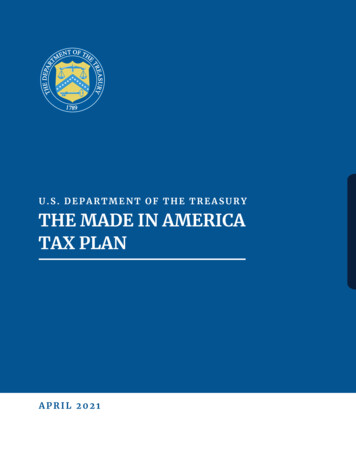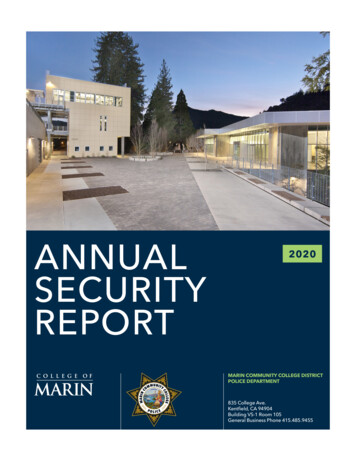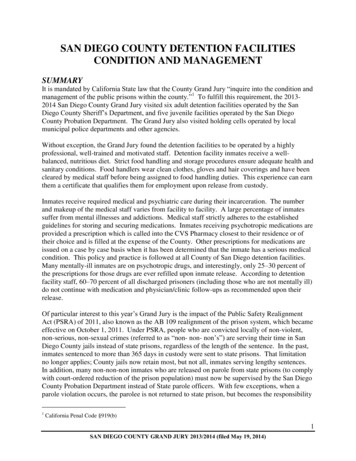
Transcription
U.S. DEPARTMENT OF THE TREASURYAPRIL 2021
Executive Summary and IntroductionLast week, President Biden proposed the American Jobs Plan, a comprehensive proposal aimed at increasing investmentin infrastructure, the production of clean energy, the care economy, and other priorities. Combined, this plan would directapproximately 1 percent of GDP towards these aims, concentrated over eight years.This report describes President Biden’s Made in America tax plan, the goal of which is to make American companies and workersmore competitive by eliminating incentives to offshore investment, substantially reducing profit shifting, countering tax competitionon corporate rates, and providing tax preferences for clean energy production. Importantly, this tax plan would generate newfunding to pay for a sustained increase in investments in infrastructure, research, and support for manufacturing, fully paying for theinvestments in the American Jobs Plan over a 15-year period and continuing to generate revenue on a permanent basis.To start, the plan reorients corporate tax revenue toward historical and international norms. Of late, the effective tax rate on U.S.profits of U.S. multinationals—the share of profits that they actually pay in federal income taxes—was just 7.8 percent.1 And althoughU.S companies are the most profitable in the world, the United States collects less in corporate tax revenues as a share of GDP thanalmost any advanced economy in the Organization for Economic Co-operation and Development (OECD).At the same time, the U.S. corporate income tax system incentivizes shifting of profits and investment abroad—and allows othercountries to undercut corporate tax rates here. For instance, a U.S. corporation making a physical investment abroad pays no U.S. taxon the first 10 percent return on foreign investment. And, both U.S. and foreign corporations still have substantial incentives to reportprofits in low tax countries and strip profits out of the United States; the latest data suggest that such profit shifting remains at recordlevels.Lastly, the current system maintains a series of incentives that distort economic outcomes. Our tax system contains tax preferencesfor fossil fuel producers and lacks sufficient incentives for climate-change mitigation. In contrast, the Made in America tax plancontains tax provisions that incentivize clean energy. It also introduces new market-based incentives for corporate research anddevelopment expenditures, complementing the spending proposals advanced in the American Jobs Plan.The President’s Made in America tax plan is guided by the following principles:1.Collecting sufficient revenue to fund critical investments. A primary objective of the Made in America tax plan is to promotecompetitiveness by funding critical new investments. Corporate tax revenues have fallen dramatically from 2 percent of GDP inthe years before the Tax Cuts and Jobs Act (TCJA) to 1 percent in the years since the enactment of TCJA.2.Building a fairer tax system that rewards labor. In recent decades, the share of national income derived from labor has declinedrelative to that derived from capital. The plan would counter the incentives in our tax code that contribute to that trend.3.Reducing profit shifting and eliminating incentives to offshore investment. The enactment of a country-by-countryminimum tax aims to substantially curtail profit shifting by U.S. multinational corporations. By tackling the profit shiftingof foreign multinational companies out of the U.S. tax base, the plan works to level the playing field between multinational1See Joint Committee on Taxation. 2021. “U.S. International Tax Policy: Overview and Analysis.” JCX-16-21, March.The Made In America Tax Plan I 1
companies headquartered in the United States and foreign countries. The President’s plan would also eliminate the tax lawsembedded in the 2017 TCJA that incentivize the offshoring of assets.4.Ending the race to the bottom around the world. Countries too often compete for multinationals’ business by reducingcorporate tax rates which makes it difficult for the United States and other countries to meet revenue needs. The President’splan provides a strong incentive for nations to join a global agreement that implements minimum tax rules worldwide throughthe denial of U.S. deductions on related party payments to foreign corporations residing in a regime that has not implemented astrong minimum tax. This aspect of the plan is designed to help level the playing field between foreign and U.S. companies.5.Requiring all corporations to pay their fair share. To ensure that large, profitable companies pay a baseline amount of taxes,the President’s plan would impose a minimum tax on firms with large discrepancies between income reported to shareholdersand that reported to the IRS. It would also provide the IRS with resources to pursue large corporations who do not meet their taxobligations, reversing a trend toward fewer corporate audits.6.Building a resilient economy to compete. To complement initiatives in the American Jobs Plan that would change the path ofenergy production in the United States and provide resources for a new research and development agenda, the tax plan wouldend long-entrenched subsidies to fossil fuels, promote nascent green technologies through targeted tax incentives, encouragethe adoption of electric vehicles, and support further deployment of alternative energy sources such as solar and wind power.The Made In America Tax Plan I 2
The Made In America Tax PlanThe current corporate income tax regime contains incentives for corporations to shift their production and profits overseas. Decliningcorporate tax revenues hinder the ability of the United States to fund investments in infrastructure, research, technology, and greenenergy. The Made in America tax plan would fundamentally reorient corporate taxation to reverse this legacy.The Made in America tax plan implements a series of corporate tax reforms to address profit shifting and offshoring incentives and tolevel the playing field between domestic and foreign corporations. These include:1.Raising the corporate income tax rate to 28 percent;2.Strengthening the global minimum tax for U.S. multinational corporations;3.Reducing incentives for foreign jurisdictions to maintain ultra-low corporate tax rates by encouraging global adoption of robustminimum taxes;4.Enacting a 15 percent minimum tax on book income of large companies that report high profits, but have little taxable income;5.Replacing flawed incentives that reward excess profits from intangible assets with more generous incentives for new researchand development;6.Replacing fossil fuel subsidies with incentives for clean energy production; and7.Ramping up enforcement to address corporate tax avoidance.These are the major elements of the Made in America tax plan, but the proposal contains several additional tax incentives that woulddirectly benefit U.S. corporations, passthrough entities, and small businesses. These include, for example, a marked increase in theresources available through the Low-Income Housing Tax Credit and other housing incentives. This report, however, is focused on theelements of the package directly related to corporate tax reform and reforming energy incentives.The Made In America Tax Plan I 3
Addressing Flaws In The Current SystemThe Made in America tax plan advances a series of reforms aimed at addressing the major flaws in the corporate tax code, includingboth shortcomings introduced through the TCJA and longstanding inefficiencies that have persisted for decades. The President’splan would make the tax code more efficient, reverse biases against labor, raise sufficient revenue to pay for critical initiatives,eliminate incentives for profit shifting and offshoring, and introduce new preferences for the production of clean energy. Combined,these reforms will have substantial benefits for the American economy.Toward a More Efficient Tax SystemThe reforms in the Made in America tax plan are aimed at improving economic efficiency. Much of the efficiency argument forlow corporate statutory rates is based on the premise that corporate investment incentives are driven by the corporate tax rate.Supporters of this line of thinking contend that higher corporate tax rates decrease investment incentives, and lower corporate taxrates improve them.Evidence following the 2017 corporate rate cut from 35 percent to 21 percent, however, did not show an increase in investmentor economic growth from trend levels, with one analysis concluding that “there is no evidence that the 2017 tax law has made asubstantial contribution to investment or longer-term economic growth.”2 In fact, a report from the International Monetary Fund(IMF) found that less than one-fifth of the increase in corporate cash balances, which were enhanced by the corporate tax cut, wasused for capital and research and development (R&D) spending. Instead, the increased corporate cash balances were directed towardfinancing buybacks and dividend payouts for shareholders.3It is unsurprising that corporate tax cuts would not spur a surge in investment since much of the corporate tax falls on “excess profits,”not normal returns. Taxing these excess profits can generate revenue without undue distortion, according to research. Moreover, a risingshare of the corporate tax base, over three-quarters by 2013, consists of excess returns. That fraction is likely even higher now, due to therising market power of large companies, as well as special provisions that exempt most normal returns from taxation.4Although the 2017 corporate tax rate cut purported to increase the competitiveness of U.S. companies, the law’s generous treatmentof corporate profits was paired with incentives for shifting profits and activities offshore. Instead of a focus on encouraginginvestments in the United States, for example, the 2017 TCJA created new offshoring incentives through two provisions, the global2See detailed evidence within: Furman, Jason. 2020. Prepared Testimony for the Hearing “The Disappearing ‘Corporate Income Tax.’” Committee on Ways andMeans, 11 February; Gravelle, Jane and Donald Marples. 2019. “The Economic Effects of the 2017 Tax Revision: Preliminary Observations.” Congressional ResearchService, 22 May; Clausing, Kimberly. 2020. “Fixing the Five Flaws of the Tax Cuts and Jobs Act.” Columbia Journal of Tax Law 11(2): 31–75.3See Kopp, Emanuel, Daniel Leigh, Suzanna Mursula, and Suchanan Tambunlertchai. 2019. “US Investment since the Tax Cuts and Jobs Act of 2017.” InternationalMonetary Fund, 31 May (https://www.imf.org/ x). This is consistent with work by Hanlon, Hoopes, andSlemrod (2019) that finds that only around 20 percent of S&P 500 companies in 2018 mentioned planned increases in investment that were linked to the 2017 taxreform (see 703226).4See Power, Laura and Austin Frerick. 2016. “Have Excess Returns to Corporations Been Increasing Over Time?” National Tax Journal 69(4): 831–46. Since thispaper, tax law has exempted much of the normal return to capital for equity-financed investment, so the corporate tax should fall even less on labor than it did inyears past. (The mechanism by which corporate taxes burden labor requires a reduction in investment.) Of note, many debt-financed investments are currentlysubsidized through the tax code. Also, the role of market power in the U.S. economy has continued to increase, making more and more of the corporate tax baseexcess profits rather than the normal return to capital. See Phillipon, Thomas. 2019. The Great Reversal: How America Gave up on Free Markets. Cambridge:Harvard University Press.The Made In America Tax Plan I 4
intangible low-tax income (GILTI) provision and the foreign-derived intangible income (FDII) deduction.5 In addition, since foreignshareholders own a significant share of U.S. equities, much of the benefits of the corporate tax cut accrued to foreign, rather thanU.S., investors.6 Combined, the current tax code provides insufficient incentives for companies to maintain operations in the UnitedStates, while rewarding those that shift profits to low-tax jurisdictions.Toward a Fairer Tax SystemThe labor share of national income has been declining for years, representing a worrying trend for workers and a contribution torising income inequality.7 This shift has many causes, but it is exacerbated by a worldwide trend of governments shifting relativetax burdens away from corporations and capital and onto workers by reducing tax rates on capital gains, dividends, and corporateincome while increasing tax burdens on sales and wages. In the case of the United States, the share of federal revenue raised by thecorporate tax has fallen steadily and is now under 10 percent, while the share of revenue raised by taxing labor has been growing fordecades and now exceeds 80 percent.Figure 1: Labor and Corporate Share of Federal Tax Revenue (1950-2019)5GILTI exempts the first 10 percent return on foreign assets; all else equal, FDII deductions are less generous as domestic assets increase. Early literature has shownthat companies have responded to these perverse incentives. For example, Beyer et al. (see https://papers.ssrn.com/sol3/papers.cfm?abstract id 3818149)find that for U.S. multinational corporations, higher levels of pre-TCJA foreign cash are associated with increased post-TCJA foreign property, plant, andequipment investments. They do not find a similar increase in domestic property, plant, and equipment. Atwood et al. (see https://papers.ssrn.com/sol3/papers.cfm?abstract id 3600978) find the GILTI provisions introduced new incentives for U.S. multinational corporations to invest in foreign target firms with lowerreturns on tangible property so that they might shield income generated in havens from U.S. tax liability under the GILTI minimum tax.6See Rosenthal, Steven and Theo Burke. 2020. “Who’s Left to Tax? US Taxation of Corporations and Their Shareholders.” senthal%20and%20Burke.pdf). Also see Congressional Budget Office. Letter to the Honorable Chris Van Hollen. 18 April 2018.7See ILO and OECD. 2015. “The Labour Share in G20 Economies.” Report. International Labour Organization and Organisation for Economic Co-operation andDevelopment; Jacobson, Margaret M. and Filippo Occhino. 2012. “Labor’s Declining Share of Income and Rising Inequality.” Federal Reserve Bank of ClevelandWorking Paper 2012-13; Karabarbounis, Loukas and Brent Neiman. 2013. “The Global Decline of the Labor Share.” Quarterly Journal of Economics 129(1): 61–103;Karabarbounis, Loukas and Brent Neiman. 2014. “Capital Depreciation and Labor Shares Around the World: Measurement and Implications.” National Bureau ofEconomic Research Working Paper 20606; Elsby, Michael W. L., Bart Hobijn, and Ayşegül Şahin. 2014. “The Decline of the U.S. Labor Share.” Brookings Papers onEconomic Activity 2013(2): 1–63.The Made In America Tax Plan I 5
This trend has implications not only for the division between labor and capital income, but also for aggregate income inequality. Sincecapital income is disproportionately concentrated among wealthier taxpayers, tax preferences for capital relative to labor imply benefitsfor upper-income taxpayers relative to those with lower levels of income. The concentration in capital income is stark: in 2019, the top 5percent of the income distribution earned just 26 percent of labor income, but 71 percent of capital income.8Since corporate tax burdens, in the short-term, are largely borne by shareholders, near-term changes in corporate tax revenueare borne in equal proportions to foreign and domestic share ownership. In the wake of the TCJA, one key critique of the law wasthat since foreign shareholders own over one-third of U.S. equities, a large share of the tax cut was a windfall gain for overseasshareholders. In fact, one analysis observed that the TCJA conferred over three times the tax benefits to foreign taxpayers as it did tomiddle-income families.9Another aspect of fairness simply concerns the “effective” tax rate paid by corporations, or the tax bill as a share of profits after allexclusions and deductions have been claimed. One feature of the U.S. tax code is the substantial discrepancy between the headlinerate and the effective tax rate; this discrepancy can often obscure discussions of international competitiveness. In fact, U.S. multinationalcorporations’ effective tax rate—the share of profits that they actually pay in federal income taxes—is just 8 percent, the result of acombination of profit shifting and tax preferences that allow large companies to shrink their tax burdens.10Toward a Tax System that Raises Needed RevenueAs a result of the tax cuts of prior years, the United States now raises only about 16 percent of GDP in federal tax revenue, a decline ofabout four percentage points in the last two decades.The corporate tax has historically raised around 2 percent of GDP in revenue. This share depends on a host of factors, including thestate of the business cycle and the division of profits between the corporate and non-corporate sectors. Still, corporate tax revenuesremained roughly constant over the past four decades. After the corporate tax cuts under the TCJA, the share of corporate taxescollected as a share of GDP fell from 2 percent to 1 percent.Table 1: Corporate Tax Revenues Relative to GDP, United States and OECD AverageBefore and After Tax Cuts and Jobs Act of 2017 (TCJA)United StatesOECD Average11Post-TCJA: 2018-20191.03.15 Years pre-TCJA: 2013-20172.02.9Years Prior: 2000-20122.03.0Source: OECD Revenue Statistics8Data are available on the Treasury OTA website (see ution-of-Income-by-Source-2019.pdf).9See Rosenthal, Steven. 2017. “Slashing Corporate Taxes: Foreign Investors are Surprise Winners.” Tax Notes Federal, 23 October.10 See Joint Committee on Taxation. 2021. “U.S. International Tax Policy: Overview and Analysis.” JCX-16-21, 19 March.11 The average for G7 countries is very similar.The Made In America Tax Plan I 6
This contrasts with rising U.S. corporate profits, which are at historic and comparative highs. In recent years, corporate profits (aftertax) as a share of GDP averaged 9.7 percent (2005-2019), whereas in the period 1980-2000, corporate profits averaged only 5.4 percentof GDP.12 The U.S. corporate sector is the most successful in the world: it hosts 37 percent of the Forbes 2000 companies by profitwhile the United States accounts for 24 percent of world GDP.In part, the divergence between U.S. corporate profits and U.S. corporate taxes arises from the incentives created by the tax code forsuccessful multinationals to shift profits overseas to avoid U.S. tax burdens.Figure 2: Corporate Profits and Taxes as a Share of GDPOverhauling corporate and international taxation can raise substantial revenue. For the past two decades, the typical OECD countryhas raised about 3 percent of GDP from corporate taxation. (See Table 1 and Figure 3.) And while the United States has historicallyraised comparatively less revenue through the corporate tax relative to our trading partners, the wedge was greatly exacerbatedby the 2017 tax law. Indeed, closing even half the gap between the U.S. corporate tax burden and the median OECD burden isapproximately sufficient to pay for the proposed initiatives in the American Jobs Plan.12 Data are from the Federal Reserve Economics Statistics database.The Made In America Tax Plan I 7
Figure 3: 2019 Corporate Tax Collection in OECD Countries as a Share of GDPToward an End to Profit Shifting and OffshoringThe right approach for corporate taxation requires balancing dual priorities: maintaining U.S. competitiveness while protecting thecorporate tax base. As noted above, corporate tax collections in the United States, however, are at historic lows and well below whatother countries collect. Simultaneously, the United States has an “America last” approach to corporate taxation, incentivizing shiftingprofits to high-tax and low-tax jurisdictions alike. By blending income streams from high and low tax countries and taking advantageof the current exclusion in the U.S. minimum tax, U.S. multinational companies can be taxed at a 50 percent discount or more relativeto their domestic peers.Until 2017, foreign profits were taxed at the domestic tax rate upon repatriation to the domestic parent firm. This created bigincentives for large companies to keep profits offshore in order to avoid U.S. tax. For the last few years, U.S. firms have been subject toa minimum tax on their global intangible low-taxed income. This tax exempts the first 10 percent of returns on foreign tangible assets,and GILTI is taxed at approximately half of the corporate tax rate (10.5 percent).13Beyond its low statutory rate and exemptions, the current GILTI regime maintains profit shifting incentives. GILTI tax liabilities arecalculated on a global basis, which leads multinationals to prefer to earn income outside the United States; this preference extends toboth higher-tax jurisdictions as well as lower-tax ones. Since taxes paid in high-tax jurisdictions can generate tax credits that allow foruntaxed profit shifting into tax havens, companies can blend the two streams of income and achieve a tax burden that is only abouthalf that of domestic companies.1413 The tax rate can be as high as 13.125 percent depending on the location of companies’ foreign operations.14 Kamin, David, David Gamage, Ari Glogower, Rebecca Kysar, Darien Shanske, Reuven Avi- Yonah, Lily Batchelder, J. Clifton Fleming, Daniel Hemel, Mitchell Kane,David Miller, Daniel Shaviro, and Manoj Viswanathan. 2019. “The Games They Will Play: Tax Games, Roadblocks and Glitches Under the 2017 Tax Overhaul.” 103Minn. L. Rev. 1439.The Made In America Tax Plan I 8
As a result, of the top 10 locations for U.S. multinational profit in 2018, seven were tax havens.15 More U.S. profits are housed in tiny taxhavens than in the major economies of China, India, Japan, France, Canada, and Germany combined. Bermuda, a country of merely64,000 people, shows 10 percent of all reported U.S. multinational foreign profit, an amount of reported profit that is many multiples ofBermuda’s GDP.16 Despite attempts to rein in profit shifting, tax havens are as available today as they were prior to the 2017 tax reform.For U.S. multinational companies, the share of total foreign income in seven prominent havens is nearly identical in the two years afterTCJA (2018 and 2019) as it was in the five years prior to the law, at 61 percent of after-tax income, or 1.5 percent of GDP.Figure 4: Share of U.S. Multinational Corporation Income in Seven Big Havens, 2000-2019Note: Data are foreign investment earnings from the U.S. Bureau of Economic Analysis (https://www.bea.gov/international/di1usdbal). The seven low-taxjurisdictions that are particularly important in these data are: Bermuda, the Caymans, Ireland, Luxembourg, the Netherlands, Singapore, and Switzerland. Thehaven share is mechanically higher than it would be in some data sources since the data are reported on an after-tax basis.Toward a Cleaner Energy SectorTax preferences for oil, gas, and coal producers today decrease their tax liabilities relative to other firms. Not only does this lead to loweroverall tax receipts, but these provisions of the tax code shift our energy production away from cleaner alternatives, undermining longterm energy independence and the fight against climate change. Subsidized fossil fuels have also negatively impacted air and waterquality in U.S. communities—especially in communities of color. Fossil fuel companies additionally benefit from substantial implicitsubsidies, since they sell products that create externalities but they do not have to pay for the damages caused by these externalities.Recent research shows how the benefits of these implicit subsides are concentrated within a handful of large firms.1715 In addition, two other countries in the top 10 have effective tax rates within one percentage point of the 10.5 percent GILTI threshold. Of the top ten countries, onlyCanada has a rate above 11.4 percent. See Table 6 of Joint Committee on Taxation. 2021. “U.S. International Tax Policy: Overview and Analysis.” JCX-16-21, 19 March.16 See Table 6 of Joint Committee on Taxation. 2021. “U.S. International Tax Policy: Overview and Analysis.” JCX-16-21, 19 March.17 See Kotchen, Matthew. 2021. “The Producer Benefits of Implicit Fossil Fuel Subsidies in the United States.” Proceedings of the National Academy of Sciences 118(14).The Made In America Tax Plan I 9
At the same time, incentives for clean energy production and investments are insufficient to match the massive scope of ourenvironmental and climate problems. For example, the production tax credit for renewable electricity producers lapsed and wasretroactively extended five times between 1999 and 2015, leading to significant policy uncertainty for renewable producers. TheBiden-Harris Administration’s climate-related commitments would remove the subsidies for fossil fuel producers and substantiallyexpand tax incentives for clean energy.A Tax Code To Bolster American CompetitivenessIn recent years, our international partners have overhauled their corporate tax codes and broadened their tax bases, raising revenues(relative to the size of their economies) well above those we collect. Efforts to rein in profit shifting in the United States, however, havemade corporate taxation worse. The U.S. raises less corporate tax revenue (as a share of GDP) than at any time since at least WorldWar II, and incentives for shifting profits and offshoring jobs outside of the United States remain. The 2017 tax law largely retainedprofit shifting incentives and increased those for offshoring.The failure of our corporate tax regime to meet the challenges of the modern era has had real consequences. Current tax laws levyhigher tax rates on labor income while entrenching preferences for capital income which disproportionately accrues to higher incometaxpayers. The President’s Plan would undo the ability of taxpayers to shield capital and corporate profits from tax liability. Thiswould curtail profit shifting, bolster U.S. tax competitiveness, and raise much-needed tax revenue.Raising the Corporate Income Tax Rate to 28 percentThe Made in America tax plan will increase the corporate tax rate from 21 percent to 28 percent. This increase maintains a tax rate oncorporate profits which is approximately 7 percentage points below the rate that was in place from the late 1980s until 2017, and it ispaired with attendant reforms designed to promote competitiveness and reward productive investments.As noted above, the United States raises less corporate tax revenue (as a share of GDP) than almost all of the advanced economiesin the OECD.18 Raising the corporate income tax rate would modestly increase corporate revenues relative to GDP, still leaving thembelow those of our trading partners.In addition to raising revenue to fund urgent fiscal priorities, raising the corporate income tax rate would also help attenuateinequality. The corporate income tax is one of the most progressive taxes in our tax system. Also, the corporate tax is an essentiallever for taxing capital in general, serving as a critical backstop to ensure that capital is taxed at least once; in the absence of thecorporate tax, a substantial share of capital income would escape taxation altogether.19The Made in America tax plan recognizes that corporate investment depends on far more than the headline tax rate.Investment alsodepends on the factors that truly shape business climate, including the health and education of our workforce, the strength of ourinstitutions, and smooth and stable relations with other countries. The President’s plan to make public investments in infrastructure,technology, research, and the green industries of the future would help lay a strong foundation for longstanding economic prosperity.It would also promote job creation in the United States, ensuring that American workers benefit from a robust domestic economy.18 See OECD data at .htm#indicator-chart.19 See Burman, Leonard E., Kimberly A. Clausing, and Lydia Austin. 2017. “Is U.S. Corporate Income Double-Taxed?” National Tax Journal 70(3): 675–706.The Made In America Tax Plan I 10
Ending Offshoring and Profit Shifting Incentives: Strengthening the Global MinimumTax for U.S. Multinational CorporationsOne of the most important objectives of the Made in America tax plan is to reduce incentives for the offshoring of American jobs whilealso limiting the ability of corporations to take advantage of corporate tax loopholes to shift their profits to low-tax jurisdictions.The plan takes aim at offshoring through a series of reforms that reverse tax-based incentives for moving production overseas.Perhaps the most consequential of these are fundamental changes to the GILTI regime introduced by the TCJA. The Made in Americatax plan would eliminate the incentive to offshore tangible assets by ending the tax exemption for the first 10 percent return onforeign assets. It would also calculate the GILTI minimum tax on a per-country basis, ending the ability of multinationals to shieldincome in tax havens from U.S. taxes with taxes paid to higher tax countries.20 The plan would also increase the GILTI minimum taxto 21 percent (up to three-quarters of the proposed new 28 percent corporate tax rate, as opposed to the current one-half ratio).In addition to th
4. Enacting a 15 percent minimum tax on book income of large companies that report high profits, but have little taxable income; 5. Replacing flawed incentives that reward excess profits from intangible assets with more











